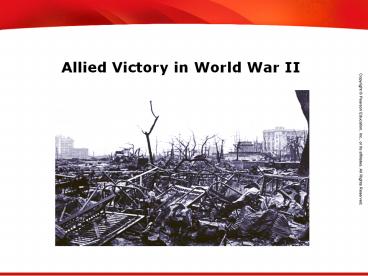Allied Victory in World War II - PowerPoint PPT Presentation
1 / 13
Title:
Allied Victory in World War II
Description:
Allied Victory in World War II Describe the reasons for the final defeat of the Nazis. Summarize how the Allies began to push back the Japanese in the Pacific. – PowerPoint PPT presentation
Number of Views:204
Avg rating:3.0/5.0
Title: Allied Victory in World War II
1
Allied Victory in World War II
2
Objectives
- Describe the reasons for the final defeat of the
Nazis. - Summarize how the Allies began to push back the
Japanese in the Pacific. - Explain the American strategy for ending the war
against Japan and the consequences of that
strategy.
3
Terms and People
- V-E Day the day the Allies achieved victory in
Europe, May 8, 1945 - Bataan Death March 65-mile march suffered by
American and Filipino prisoners of the Japanese - Douglas MacArthur American general who led U.S.
forces in the battles to defeat Japan - island-hopping the act of recapturing some
Japanese-held islands while bypassing others
4
Terms and People (continued)
- kamikaze Japanese pilot who undertook a suicide
mission - Manhattan Project code name for a collaboration
of Allied scientists who raced to test the first
atomic bomb - Hiroshima city in Japan where the first atomic
bomb was dropped in August 1945 - Nagasaki city in Japan where the second atomic
bomb was dropped in August 1945
5
How did the Allies finally defeat the Axis powers?
By 1945, the war in Europe was nearing its end.
Germany was being attacked from east and west,
and Axis armies were surrendering. In the
Pacific, a series of bloody battles continued on
the islands as Allied military leaders planned a
land invasion of Japan. World War II finally
ended when the United States dropped atomic bombs
on two Japanese cities.
6
In the spring of 1945, the Nazis were surrounded
and defeated.
- From the west the Allies surged into Germany, and
from the east Soviet troops closed in on Berlin. - In Italy, guerrillas captured and executed
Mussolini. Hitler committed suicide.
The Allies proclaimed May 8, 1945, V-E Day.
7
- Germanys geographic location left it open to
invasion from all sides. - Hitler made some poor military decisions.
- The Soviet army proved far stronger than
expected. - The United States had an enormous capacity for
industrial production.
There were several reasons why the mighty Axis
powers fell to the Allies.
8
The Allies could now focus on defeating Japan.
9
In the summer of 1942, U.S. Marines defeated the
Japanese at Guadalcanal. Led by General Douglas
MacArthur, they began an island-hopping strategy
to move north toward Japan.
10
The Allied advance toward Japan
11
Meanwhile, Allied scientists offered another way
to end the war.
- They worked on splitting the atom to create a new
kind of bomb. - In July 1945, the Manhattan Project successfully
tested the first atomic bomb in New Mexico. - Harry Truman, who had become president after the
death of Roosevelt, realized that it was a
terrible new force for destruction. Nevertheless,
he decided to use the new weapon against Japan.
12
Allied leaders warned Japan to surrender or face
destruction. Japan ignored the warning.
On August 6, 1945, U.S. planes dropped the first
atomic bomb on Hiroshima, instantly killing more
than 70,000 people.
13
August 8 The Soviet Union invaded Manchuria. The
Japanese did not respond. August 9 The United
States dropped a second atomic bomb on Nagasaki.
This time, more than 40,000 people were
killed. August 10 Emperor Hirohito intervened
and forced the government to surrender. September
2, 1945 A formal peace treaty was signed.

